Applies To:
Show Versions
BIG-IP AAM
- 11.6.5, 11.6.4, 11.6.3, 11.6.2, 11.6.1, 11.5.10, 11.5.9, 11.5.8, 11.5.7, 11.5.6, 11.5.5, 11.5.4, 11.5.3, 11.5.2, 11.5.1
BIG-IP APM
- 11.6.5, 11.6.4, 11.6.3, 11.6.2, 11.6.1, 11.5.10, 11.5.9, 11.5.8, 11.5.7, 11.5.6, 11.5.5, 11.5.4, 11.5.3, 11.5.2, 11.5.1
BIG-IP GTM
- 11.6.5, 11.6.4, 11.6.3, 11.6.2, 11.6.1, 11.5.10, 11.5.9, 11.5.8, 11.5.7, 11.5.6, 11.5.5, 11.5.4, 11.5.3, 11.5.2, 11.5.1
BIG-IP Analytics
- 11.6.5, 11.6.4, 11.6.3, 11.6.2, 11.6.1, 11.5.10, 11.5.9, 11.5.8, 11.5.7, 11.5.6, 11.5.5, 11.5.4, 11.5.3, 11.5.2, 11.5.1
BIG-IP Link Controller
- 11.6.5, 11.6.4, 11.6.3, 11.6.2, 11.6.1, 11.5.10, 11.5.9, 11.5.8, 11.5.7, 11.5.6, 11.5.5, 11.5.4, 11.5.3, 11.5.2, 11.5.1
BIG-IP LTM
- 11.6.5, 11.6.4, 11.6.3, 11.6.2, 11.6.1, 11.5.10, 11.5.9, 11.5.8, 11.5.7, 11.5.6, 11.5.5, 11.5.4, 11.5.3, 11.5.2, 11.5.1
BIG-IP PEM
- 11.6.5, 11.6.4, 11.6.3, 11.6.2, 11.6.1, 11.5.10, 11.5.9, 11.5.8, 11.5.7, 11.5.6, 11.5.5, 11.5.4, 11.5.3, 11.5.2, 11.5.1
BIG-IP AFM
- 11.6.5, 11.6.4, 11.6.3, 11.6.2, 11.6.1, 11.5.10, 11.5.9, 11.5.8, 11.5.7, 11.5.6, 11.5.5, 11.5.4, 11.5.3, 11.5.2, 11.5.1
BIG-IP ASM
- 11.6.5, 11.6.4, 11.6.3, 11.6.2, 11.6.1, 11.5.10, 11.5.9, 11.5.8, 11.5.7, 11.5.6, 11.5.5, 11.5.4, 11.5.3, 11.5.2, 11.5.1
Introduction to upgrading version 11.x BIG-IP software
Version 11.x BIG-IP systems are typically configured to employ the functionality of a device group. When you upgrade version 11.x BIG-IP software for a BIG-IP system device group, to the new version software, you can use a simple sequence of steps to successfully upgrade each device within the device group. The following steps enable you to prepare for a software upgrade, perform the upgrade, and then verify that the upgrade successfully completed.
- Preparing BIG-IP modules for an upgrade
- Preparing BIG-IP device groups for an upgrade
- Upgrading each device within the device group
- Changing states of the traffic groups
- Configuring HA groups (if applicable)
- Configuring module-specific settings
- Verifying the software upgrade for the device group
Overview: Upgrading a version 11.x BIG-IP device group
A BIG-IP system device group for version 11.x includes two or more BIG-IP systems, with one or more traffic groups operating in active state. In this example, a version 11.x device group includes one BIG-IP system with traffic-group-1 operating in active state (Device A), one BIG-IP system with traffic-group-2 operating in active state (Device B), and one BIG-IP system with traffic-group-3 operating in active state (Device C).
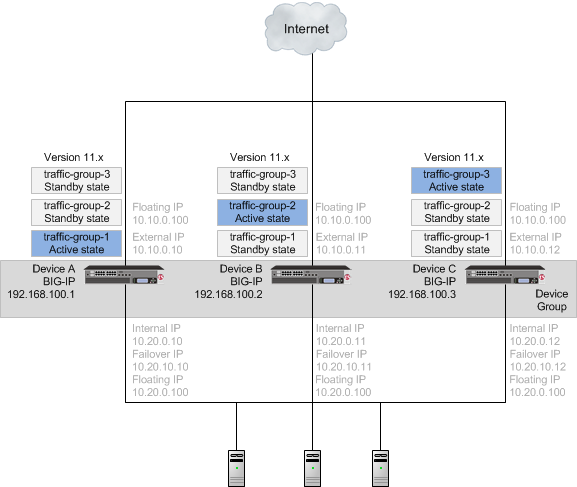 A version 11.x device group
A version 11.x device group
When upgrading an 11.x device group to the new version software, you first need to prepare your devices. After preparing the devices, you force Device A to offline state, and install the new version software onto Device A. When you finish the installation of the new version software onto Device A, the traffic groups remain in standby state on Device A, and in active state on Device B and Device C.
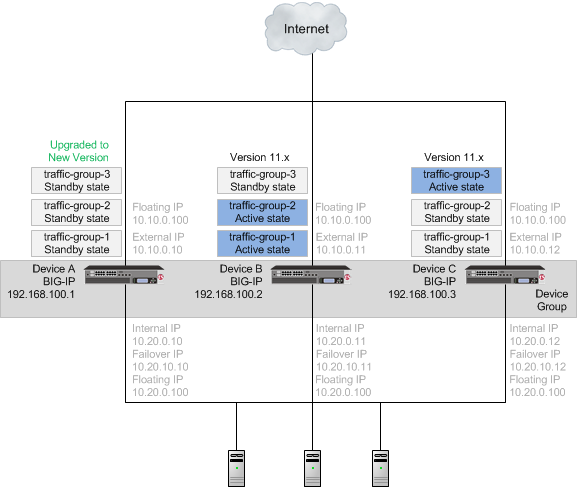 A device group with Device A upgraded to the new version software, and traffic
groups in standby state
A device group with Device A upgraded to the new version software, and traffic
groups in standby state
With the new version software installed on Device A and all traffic groups in standby state, you force Device B to offline state, changing the traffic groups on Device A to active state so that they can pass traffic. You can then install the new version software onto Device B, and reboot Device B to the location of the new version software image.
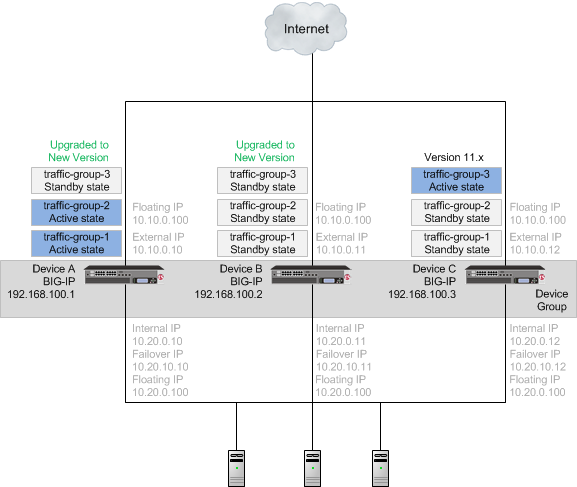 A device group with Device B upgraded to the new version software, and traffic
groups in standby state
A device group with Device B upgraded to the new version software, and traffic
groups in standby state
Once Device B reboots, you can force Device C to offline state, making traffic-group-3 active on Device B. When you complete upgrading Device C to the new version software and reboot Device C, the BIG-IP configuration includes traffic-group-1 and traffic-group-2 in active state on Device A, traffic-group-3 in active state on Device B, and a device group that includes all devices. If you use HA groups, observe that the HA group on Device A, Device B, and Device C applies to each traffic group.
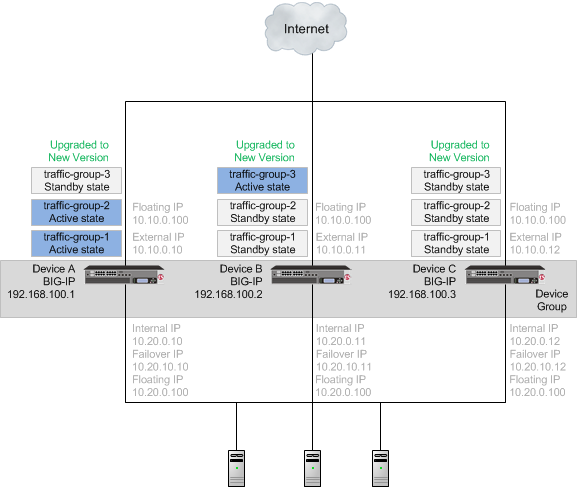 A device group with all devices upgraded to the new version software
A device group with all devices upgraded to the new version software
Once each device is upgraded to the new version software, you can reconfigure the traffic groups to become active on the devices that you want by forcing the active traffic group on a device to standby state. When forcing the traffic group to standby state, you can target the device upon which you want that traffic group to run in active state. For example, you can force traffic-group-2 on Device A into standby state, and into active state on Device B, and then force traffic-group-3 on Device B into standby state, and into active state on Device C. Additionally, if you use HA groups, you can create a unique HA group for each traffic group on each device.
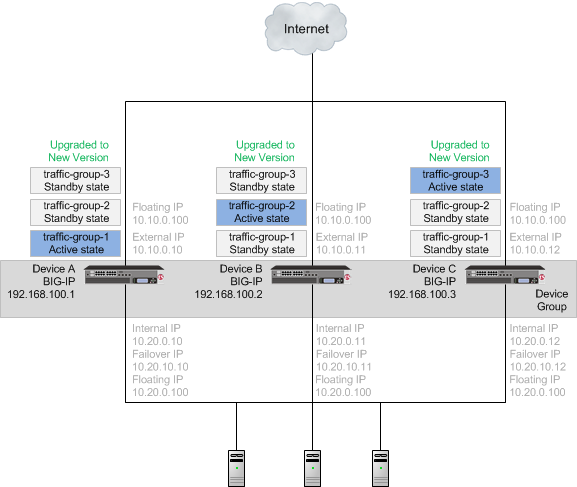 A device group with an active traffic group on each device
A device group with an active traffic group on each device
Summary of tasks
| Task | Description |
|---|---|
| Preparing the devices in the device group | In preparing to upgrade the BIG-IP systems to the new version software, you need to understand any specific configuration or functional changes from the previous version, and prepare the systems. You also download the new version of software from the AskF5 web site (http://support.f5.com/kb/en-us.html) and import the files onto each device. |
| Upgrading Device A | When you complete preparation of Device A, you can force that
device to offline state, changing those traffic groups to active
state on another device in the traffic group, and then upgrade the
software on Device A.
Important: Once Device A reboots,
if the BIG-IP system is configured to use a network HSM, you
must reinstall network HSM client software on Device A before
upgrading Device B, to ensure that traffic groups using the
network HSM function properly.
|
| Upgrading Device B | When you complete preparation of Device B, you can force that
device to offline state, changing those traffic groups to active
state on another device in the traffic group, and then upgrade the
software on Device B.
Important: Once Device B reboots,
if the BIG-IP system is configured to use a network HSM, you
must reinstall network HSM client software on Device B before
upgrading Device C, to ensure that traffic groups using the
network HSM function properly.
|
| Upgrading Device C | When you complete preparation of Device C, you can force that
device to offline state, changing those traffic groups to active
state on another device in the traffic group, and then upgrade the
software on Device C.
Important: Once Device C reboots,
if the BIG-IP system is configured to use a network HSM, you
must reinstall network HSM client software on Device C to ensure
that traffic groups using the network HSM function
properly.
|
| Changing states of traffic groups | When you finish upgrading all of the devices, you can restore the configuration of active traffic groups on each device. |
| Verifying the upgrade | Finally, you should verify that the BIG-IP device group is functioning properly. |
| Configuring HA groups | When you finish upgrading a device, the HA group on the device (in version 11.5, and later) applies to a traffic group, as opposed to the device. You can create a unique HA group for each traffic group on each device, as necessary. |
| Configuring module-specific settings | According to your understanding of the configuration and functional changes from the previous version, you can reconfigure any customized module settings. |
DSC components
Device service clustering (DSC) is based on a few key components.
- Devices
- A device is a physical or virtual BIG-IP system, as well as a member of a local trust domain and a device group. Each device member has a set of unique identification properties that the BIG-IP system generates. For device groups configured for failover, it is important that the device with the smallest capacity has the capacity to process all traffic groups. This ensures application availability in the event that all but one device in the device group become unavailable for any reason.
- Device groups
- A device group is a collection of BIG-IP devices that trust each other and can
synchronize, and sometimes fail over, their BIG-IP configuration data. You can create two
types of devices groups: A Sync-Failover device group contains devices that
synchronize configuration data and support traffic groups for failover purposes when a
device becomes unavailable. A Sync-Only device group contains devices that
synchronize configuration data, such as policy data, but do not synchronize failover
objects. The BIG-IP system supports either homogeneous or heterogeneous hardware platforms
within a device group. Important: BIG-IP module provisioning must be equivalent on all devices within a device group. For example, module provisioning is equivalent when all device group members are provisioned to run BIG-IP Local Traffic Manager (LTM) and BIG-IP Application Security Manager (ASM) only. Maintaining equivalent module provisioning on all devices ensures that any device in the device group can process module-specific application traffic in the event of failover from another device.
- Traffic groups
- A traffic group is a collection of related configuration objects (such as a virtual IP address and a self IP address) that run on a BIG-IP device and process a particular type of application traffic. When a BIG-IP device becomes unavailable, a traffic group can float to another device in a device group to ensure that application traffic continues to be processed with little to no interruption in service.
- Device trust and trust domains
- Underlying the success of device groups and traffic groups is a feature known as device trust. Device trust establishes trust relationships between BIG-IP devices on the network, through mutual certificate-based authentication. A trust domain is a collection of BIG-IP devices that trust one another and can therefore synchronize and fail over their BIG-IP configuration data, as well as exchange status and failover messages on a regular basis. A local trust domain is a trust domain that includes the local device, that is, the device you are currently logged in to.
- Folders
- Folders are containers for the configuration objects on a BIG-IP device. For every administrative partition on the BIG-IP system, there is a high-level folder. At the highest level of the folder hierarchy is a folder named root. The BIG-IP system uses folders to affect the level of granularity to which it synchronizes configuration data to other devices in the device group.
About traffic groups
A traffic group is a collection of related configuration objects, such as a floating self IP address, a virtual IP address, and a SNAT translation address, that run on a BIG-IP device. Together, these objects process a particular type of application traffic on that device. When a BIG-IP device becomes unavailable, a traffic group floats (that is, fails over) to another device in a device group to ensure that application traffic continues to be processed with little to no interruption in service. In general, a traffic group ensures that when a device becomes unavailable, all of the failover objects in the traffic group fail over to any one of the available devices in the device group.
A traffic group is initially active on the device on which you create it, until the traffic group fails over to another device. For example, if you initially create three traffic groups on Device A, these traffic groups remain active on Device A until one or more traffic groups fail over to another device. If you want an active traffic group to become active on a different device in the device group when failover has not occurred, you can intentionally force the traffic group to switch to a standby state, thereby causing failover to another device.
Only objects with floating IP addresses can be members of a floating traffic group.
An example of a set of objects in a traffic group is an iApps application service. If a device with this traffic group is a member of a device group, and the device becomes unavailable, the traffic group floats to another member of the device group, and that member becomes the device that processes the application traffic.
About forcing a device offline
You can force a BIG-IP device into an offline state, which stops that device from processing or responding to local traffic connections. When the device is in offline state, you can upgrade the software on that device or perform maintenance on that device.
When the BIG-IP system is forced offline, it terminates existing connections to local traffic objects, such as virtual servers, SNATs, and so on. In the forced offline state, the BIG-IP system does not allow new connections.
For BIG-IP systems running software version 11.1.0 and later, the Force Offline status persists through system reboots and upgrades. For BIG-IP systems running software versions earlier than 11.1.0, the Force Offline status does not persist through system reboots.
- On appliance systems, the system maintains connections to self IP addresses.
- On VIPRION systems, the system terminates connections to self IP addresses, and does not allow new connections.
When you force VIPRION platforms offline, make sure to manage the system by using the management port or console. The system terminates connections to self IP addresses when you force the platform offline.
You will want to force the standby devices offline before you change the redundancy state (such as resetting the device trust for a device group). Forcing standby devices into offline state prevents a standby device from unexpectedly becoming active.
Task summary
The upgrade process involves preparation of the BIG-IP devices (Device A, Device B, and Device C) configured in device group, followed by the installation and verification of the new version software on each device. When you upgrade each device, you perform several tasks. Completing these tasks results in a successful upgrade to the new version software on all BIG-IP devices, with the device group configured properly.
Preparing BIG-IP modules for an upgrade from version 11.x
Application Acceleration Manager preparation
BIG-IP Application Acceleration Manager (AAM) modules require specific preparation tasks and changes to upgrade from version 11.x to the new version software. No additional configuration is required after completing the upgrade to the new version software.
Preparation activities
Before you upgrade the BIG-IP Application Acceleration Manager (AAM) modules from version 11.x to the new version software, you need to prepare the systems, based on your configuration. The following table summarizes the applicable tasks that you need to complete.
| Feature or Functionality | Preparation Task |
|---|---|
| Unpublished policies | You must publish any policies that you want to migrate to the new version software. Only published policies are migrated into the new version software. |
Advanced Firewall Manager system preparation
The BIG-IP Advanced Firewall Manager (AFM) system does not require specific preparation when upgrading from version 11.x to the new version software. No additional configuration is required after completing the upgrade to the new version software.
Access Policy Manager system preparation
The Access Policy Manager system does not require specific preparation when upgrading from version 11.x to the new version software. However, additional configuration might be required after completing the upgrade to the new version software.
Supported high availability configuration for Access Policy Manager
Access Policy Manager is supported in an active-standby configuration with two BIG-IP systems only.
Post-upgrade activities
When you finish upgrading to the new version software, you should consider the following feature or functionality changes that occur for the Access Policy Manager systems. Depending on your configuration, you might need to perform these changes after you upgrade your systems.
| Feature or Functionality | Description |
|---|---|
| Sessions | All users currently logged in while the upgrade occurs will need to log in again. |
| Authentication agents and SSO methods | If you have deployments using ActiveSync or Outlook Anywhere, where the domain name is part of the user name, you should enable the Split domain from username option in the login page agent if the authentication method used in the access policy requires only the user name for authentication. |
Application Security Manager system preparation
The BIG-IP Application Security Manager (ASM) system does not require specific preparation when upgrading from version 11.x to the new version software. No additional configuration is required after completing the upgrade to the new version software.
What to expect after upgrading a redundant system
If you update two redundant systems that are running as an active-standby pair with BIG-IP Application Security Manager (ASM) and BIG-IP Local Traffic Manager (LTM) provisioned, the system maintains the active-standby status and automatically creates a Sync-Failover device group and a traffic group containing both systems. The device group is enabled for BIG-IP ASM (because both systems have ASM provisioned).
You can manually push or pull the updates (including BIG-IP LTM and ASM configurations and policies) from one system to the other (, click the name of a device, and then choose Sync Device to Group or Sync Group to Device).
Global Traffic Manager system preparation and configuration
BIG-IP Global Traffic Manager systems require specific preparation and configuration when upgrading from version 11.x to the new version software.
Preparation activities
You should complete these activities before upgrading Global Traffic Manager systems from version 11.x to the new version software (BIG-IP DNS).
| Activity | Instructions |
|---|---|
| Verify that the device certificates are current, and that expiration does not occur until after upgrading. |
|
| Disable configuration synchronization and DNS zone files synchronization.
Note: To use a backup UCS file without synchronizing the GTM
configuration, disable synchronization. If synchronization is enabled, restoring
the UCS backup file loads the configuration and initiates
synchronization.
|
|
Post-upgrade activities
You should complete these tasks after upgrading BIG-IP DNS systems from 11.x to the new version software.
- From the command line, run the big3d_install script on the first BIG-IP
DNS system that you upgraded, so that you can monitor other BIG-IP DNS systems.Important: Run this script only once, only from the first BIG-IP DNS system that you upgraded. This step momentary degrades monitoring performance as new big3d agents start.
- On each device, verify the configuration.
- On each device, test queries against listeners.
- On each device, verify iQuery connections by using the tmsh command tmsh show /gtm iquery all.
- Enable synchronization on each device.
- Verify configuration synchronization by using a dummy test object; for example, by using an object that can be deleted after the configuration synchronization is verified as operational.
Link Controller system preparation
The BIG-IP Link Controller (LC) system does not require specific preparation when upgrading from version 11.x to the new version software. No additional configuration is required after completing the upgrade to the new version software.
Local Traffic Manager system preparation
The BIG-IP Local Traffic Manager (LTM) system does not require specific preparation when upgrading from version 11.x to the new version software. No additional configuration is required after completing the upgrade to the new version software.
HTTP Class profiles
F5 Networks replaced the HTTP Class profile in BIG-IP version 11.4.0, and later, with the introduction of the Local Traffic Policies feature. During an upgrade to BIG-IP version 11.4.0, if your configuration contains an HTTP Class profile, the BIG-IP system attempts to migrate the HTTP Class profile to an equivalent local traffic policy. For additional support information regarding the change of HTTP Class profiles to Local Traffic Policies, refer to SOL14409 on www.askf5.com.Preparing BIG-IP device groups for an upgrade
- The BIG-IP systems (Device A, Device B, and Device C) are configured as a device group.
- Each BIG-IP device is running the same version of 11.x software.
- The BIG-IP version 11.x devices are the same model of hardware.
Upgrading the Device A system
- Each device must be prepared to upgrade Device A with the new version software.
- Either the latest hotfix image file, if available, or the new version software image file is downloaded and accessible.
Upgrading the Device B system
- Device B must be prepared to upgrade the software to new version software.
- Either the latest hotfix image file, if available, or the new version software image file is downloaded and accessible.
- If the BIG-IP system is configured to use a network hardware security module (HSM), you must reinstall network HSM client software on Device A before upgrading Device B, to ensure that traffic groups using the network HSM function properly.
- Device A (the new version BIG-IP device) is in standby state.
Upgrading the Device C system
- Device C must be prepared to upgrade the software to new version software.
- Either the latest hotfix image file, if available, or the new version software image file is downloaded and accessible.
- If the BIG-IP system is configured to use a network hardware security module (HSM), you must reinstall network HSM client software on Device B before upgrading Device C, to ensure that traffic groups using the network HSM function properly.
- Device C is in active state.
Changing states of the traffic groups
Manually configuring active state traffic groups across devices within a device group involves forcing an active state traffic group on a device to standby state, and retargeting that active state traffic group to a different device. Completing these tasks results in active state traffic groups on the appropriate devices in a device group.
Viewing a list of traffic groups for a device
- On the Main tab, click .
- In the Name column, view the names of the traffic groups on the local device.
Forcing a traffic group to a standby state
You perform this task when you want the selected traffic group on the local device to fail over to another device (that is, switch to a Standby state). Users typically perform this task when no automated method is configured for a traffic group, such as auto-failback or an HA group. By forcing the traffic group into a Standby state, the traffic group becomes active on another device in the device group. For device groups with more than two members, you can choose the specific device to which the traffic group fails over.
Verifying a BIG-IP device group upgrade
-
Verify the Platform configuration for each device.
- On the Main menu, click .
- For the Root Folder Device Group setting, verify that the device group is identical on each device.
- From the Root Folder Traffic Group list, verify that the correct traffic group (traffic-group-1) is selected.
-
Verify the configuration for each device.
-
Verify the traffic groups for each device.
- On the Main menu, click .
- From the Name list, click a traffic group.
- If you configured MAC Masquerade addresses for VLANs on the devices, verify that the traffic-group-1 includes an address in the MAC Masquerade Address field.
- Verify that the floating traffic group is correct.
- Verify that the failover objects are correct.
-
Verify the Current ConfigSync State for each device.
- On the Main menu, click .
- In the Devices area of the screen, in the Sync Status column, verify that each device shows a sync status of green.
Implementation result
Your upgrade of the BIG-IP device group from version 11.x to the new version software is now complete. The new version software configuration includes a device group with three devices (Device A, Device B, and Device C) and three traffic groups (traffic-group-1, traffic-group-2, and traffic-group-3), with a traffic group on each device in active state.
 An upgraded device group
An upgraded device group





